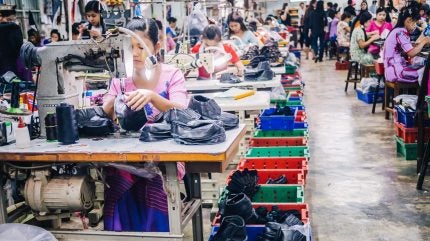
The Southeast Asia manufacturing ranking comes as global trade tensions and geopolitical uncertainties are prompting companies to reassess their supply chain configurations.
The research draws on Verisk’s Cost of Labour Index (CLI) and Human Capital Availability Index (HCAI) to rank countries on their attractiveness to foreign investors.

Discover B2B Marketing That Performs
Combine business intelligence and editorial excellence to reach engaged professionals across 36 leading media platforms.
Vietnam stands out within the region and ranks 13th globally. Its improvements in human capital factors contribute to its appeal as a hub for textiles, consumer goods and electronics.
Despite a 20% increase in average monthly wages over five years, the research explains the country maintains competitive wage levels.
Indonesia, positioned at number 17, is a strong contender in the region. However, its intricate regulatory framework, fluctuating policies, and infrastructural hurdles have impeded its capacity to draw investments in more sophisticated industries, which other areas have managed to secure, the research notes.
China remains deeply embedded in global supply chains despite efforts to diversify away from it.

US Tariffs are shifting - will you react or anticipate?
Don’t let policy changes catch you off guard. Stay proactive with real-time data and expert analysis.
By GlobalDataChina ranks 24th as its quality workforce and relatively competitive wages continue to attract investment. However, rising manufacturing wages and geopolitical tensions are influencing corporate strategies.
Similarly, Thailand ranks well in 31st place, but it faces challenges such as decelerating productivity and demographic constraints. These issues, along with ongoing political unrest, are likely to affect the country’s prospects for sustained investment over time.
India’s potential is hindered by underinvestment in education and healthcare and the emigration of skilled professionals, the research revealed. India ranked 72nd globally as its human capital strength lags behind other Asian nations despite its abundant labour force.
Bangladesh, which is one of the world’s largest textile and apparel manufacturers, featured in 64th place out of the 192 countries studied.
Verisk Maplecroft senior analyst Jess Middleton said: “Finding locations that balance cost competitiveness with workforce capability is a rising challenge, as wages climb across developed and emerging economies alike, productivity slows and demographic pressures reshape workforce availability. Recent US tariff proposals targeting a broader swathe of exporters have clouded the wider regional outlook for Southeast Asia, but it remains a highly important hub for supply chains.”
The study also talks about how nearshoring trends are reshaping investment patterns in the face of changing trade policies, including potential US tariffs on major exporters.
Mexico is gaining prominence as a key nearshoring hub, ranking 37th globally in Verisk Maplecroft’s combined labour cost and human capital indices, according to the data.
The country’s competitive labour costs, geographical closeness to the US, and integration into the United States-Mexico-Canada Agreement (USMCA) trade agreement make it an attractive option for companies looking to relocate their operations closer to the US market.
Despite a significant increase in average earnings, indicative of improved labour standards and quality of life, wages in Mexico are still considerably lower than those in the US.
Nevertheless, ongoing uncertainties in US-Mexico trade relations present potential risks for investors considering nearshoring to Mexico, according to the research.
Central and Eastern European countries like Poland, Romania, Hungary, and Bulgaria serve as attractive nearshoring destinations for European markets due to lower wages and strong education systems. However, demographic changes and rising wages could impact these regions’ future competitiveness.
Advanced economies such as South Korea, the US, Germany, the UK, and Australia lead in human capital availability but face challenges from declining working-age populations.
In contrast, sub-Saharan Africa offers the lowest labour costs but struggles with significant human capital challenges such as deficiencies in education and workforce training. The HCAI figure shows that 17 out of the 20 lowest-ranked countries are from Africa.
Nonetheless, the continent’s growing working-age population presents opportunities for companies willing to invest in skills development.
The growth in the working-age population of African nations like Nigeria, Ethiopia, and Tanzania, is projected at 40-60% in the coming years. This is said to present opportunities for businesses ready to invest in local skill enhancement and capacity building.





